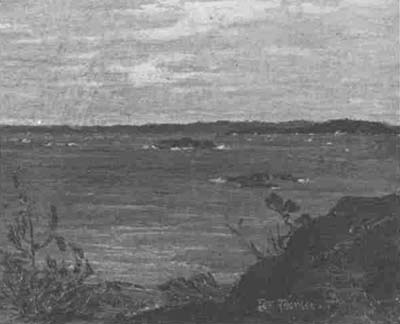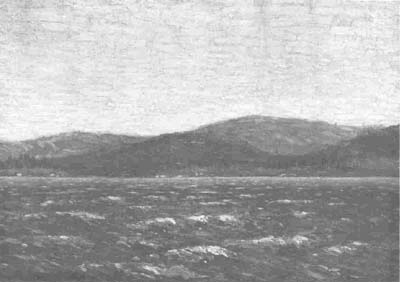
Bulletin 16, 1970
Home
Français
Introduction
History
Annual Index
Author &
Subject
Credits
Contact


Photographs
by Tom Thomson
by Dennis Reid, Curator of Post-Confederation Art
Résumé en français
Pages 1 | 2 |
3 | 4 |
5 | 6
| 7 | 8
Tom Thomson was a
man with a message. He might have been a musician, a poet or a
dramatist. What he had to say had to be said. Circumstances of
environment turned him towards form and color. Thomson was not a man
with a medium seeking adequate objects for his brush. He was a man
with the theme innate within him, groping about for seven-eighths of
his life for a medium. (1)
What he achieved with paint in that one-eighth of his life has
remained remarkable to us. Those few works from the three and
one-half years of his artistic maturity have led us, almost
desperately at times, to try to find significance in the activities
of his first thirty-five years. But as each new document or artifact
concerning his pre-Algonquin years is discovered, it becomes more
and more clear that Thomson's capacity to live creatively was fully
realized only when, after 1912, he had decided to live as much as
possible in the north.
That decision obviously drew upon, and in turn nurtured, perceptions
of great importance. And it is those perceptions - manifest in his
paintings - that will continue to attract us with the clarity and
beauty of their significance. His paintings are his greatest,
virtually his only, expression of his place in being. As A. Y.
Jackson has told us, "He never spoke in public nor wrote more
than short notes." (2) But there does exist another body of
material which reflects his relationship to the things about him,
and which also carries some small part of his "message."
Amazingly enough, this group of forty photographs, taken during the
last seven years of his life, lay undisturbed for fifty years! Mrs.
F. E. Fisk - whose mother, Mrs. T. J. Harkness, was Tom's oldest sister
and, with Mr. Harkness, the executor of his estate-discovered the
small bundle of negatives among Thomson's still carefully preserved
belongings in 1967. She had them printed, and began to show them to
people who had an interest in her uncle Tom. (3) Ottelyn Addison
published two of these photographs, both unfortunately cropped, in
her recent book on Thomson. (4) This is the first time that any have
been published in their full image. For the sake of completeness,
all forty of the photographs are reproduced here.
Do these photographs have anything to do with art? Certain
attitudes in the use of a camera have been considered as serious
artistic expression for some time now, and on a popular level
photographs have always had an important place in everyday life. But
it is only recently that those who are interested in photography as
conscious expression have shown a growing awareness of the special
quality common to all photographs. Photography is an act of the
moment above all else. More easily than any other form, it records
what is seen - and I mean "seen" in both the literal and the
"insight" sense. The photographic record maintains an
emphatic reality. What this means is that all photographs are
engaging; old photographs are engaging to a degree that surpasses
the charm of mediocre old paintings; and photographs taken by
artists always express to a notable degree what and how the artist
sees, no matter how unskilled he is in operating the camera
machine. If the artist's usual form of expression is dependent
upon the presentation of a moment of experience, as was Thomson's,
then the pertinence of even casual photographs is obvious. If only
Monet could have left an album of his favourite coloured snapshots!
Did Thomson take these snapshots as seriously as I do believe that he
did. In fact he only once wrote of himself taking photographs. (5) But
he must have been intimately familiar with the commercial
photographic techniques used around the advertising studios in which
he was employed. (6) Many of his friends also took photographs
regularly, (7) and at least one friend, Maud Varley, developed and
printed her own snapshots. (8) A simple box camera and casually taken
snapshots would have been a natural part of Thomson's daily life. (9)
But there would have been no question of such snapshots having
anything to do with art. That activity, for Thomson, was conducted
exclusively in paint. (10)
What, then, have these photographs to do with Thomson's painting?
Their main interest, apart from the stunning beauty of some of the
images, lies in the fact that they represent a largely-unconscious
parallel expression of the concerns Thomson displays in his
paintings. Thus they not only confirm Blodwen Davies's contention
that Thomson was "a man with the theme innate within him,"
they in fact clarify that theme. This involves not only what Thomson
recorded, but how he recorded it. Examining some of his paintings
along with his photographs, we see that he often strove to bring the
"what" is seen and the "how" it is seen together
into a perfectly fused experience, just as happens in a snapshot.
His most successful sketches, such as Parry Sound Harbour of
1914, (11) excite us primarily because of this unity of conception and
execution. The image is full of the vital presence of the artist,
yet retains an almost dispassionate fidelity to the place itself.
This kind of effect seems also to be inherent in such snapshots as
photograph 3. (12)
Thomson's actual sketching technique, which he shared with most of
the painters who later became the Group of Seven, at times appears
to emulate the activity of the camera. He strove for the emphatic
reality of the moment. The consequent note of urgency, although
evident in the finished work, is, in his better sketches, saved from
appearing sloppy by the intense rigour of their reality (see fig. I)
.The open-sided horizontal composition so prevalent in Group of
Seven sketches is also a normal characteristic of the snapshot. A
sketch like Grey Day, Giant's Tomb (fig. I) could, in
black-and-white reproduction, almost pass as a photograph. His
most intensely involving canvases, such as Petawawa Gorges of
1916, (13) also display this affinity with the photograph. Although
in my opinion his greatest work, this painting is not the one most
widely admired. As in all art that makes the "how" a part
of the "what" the meaning of the picture arises from the
actual experience of the viewer in looking, rather than from the
viewer's successful recognition of the image depicted. In Petawawa
Gorges, or in the earlier Lake in Algonquin Park (fig.
2), Thomson has made little concession to anecdotal interest. The
seeming simplicity of such works permits us to compare not only
the attitude involved in their making to that involved in the taking
of snap-shots, but also even the This apparent simplicity, found
command of experience they display.
Next Page | Camera
image
1 | 2 |
3 | 4 |
5 | 6
| 7 | 8
Annual Index | Author & Subject | Credits | Contact
This digital collection
was produced under contract to Canada's Digital Collections program,
Industry Canada.
"Digital
Collections Program, Copyright
© National Gallery of
Canada 2001"